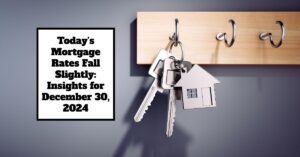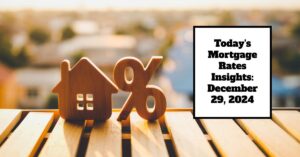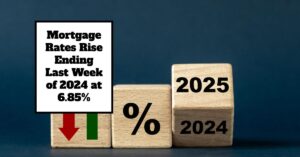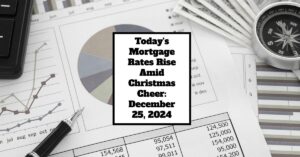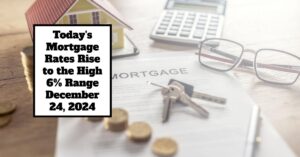As of December 31, 2024, mortgage rates have displayed a noteworthy decrease across various terms, bringing both hope and opportunity to prospective homebuyers and those considering refinancing their existing mortgages.
According to Zillow's data, the 30-year fixed mortgage rate is currently at 6.64%, a drop of eight basis points, while the 15-year fixed rate has decreased to 6.03%, down nine basis points. This trend reinforces the idea that now could be an advantageous time to engage in the housing market, especially as rates are projected to gradually decline further in 2025.
Today's Mortgage Rates Fall: December 31, 2024 Insights
Key Takeaways
- 30-Year Fixed Rate: 6.64% (decreased by 8 basis points)
- 15-Year Fixed Rate: 6.03% (decreased by 9 basis points)
- Adjustable-Rate Mortgages (ARMs): Rates range from 6.57% to 6.71%
- VA Loans: Rates for 30-year VA loans are at 6.08%
- Expected downward trend in 2025, but rate decreases are anticipated to be gradual.
Current Mortgage Rates
Here’s a closer look at today’s mortgage rates for various types of mortgages, which may help guide your decision-making process:
Purchase Mortgage Rates
| Mortgage Type | Interest Rate | Change |
|---|---|---|
| 30-Year Fixed | 6.64% | -0.08 |
| 20-Year Fixed | 6.48% | -0.10 |
| 15-Year Fixed | 6.03% | -0.09 |
| 5/1 ARM | 6.71% | -0.05 |
| 7/1 ARM | 6.57% | -0.04 |
| 30-Year VA | 6.08% | -0.04 |
| 15-Year VA | 5.63% | -0.07 |
| 5/1 VA | 6.27% | -0.03 |
Mortgage Refinance Rates
| Mortgage Type | Interest Rate | Change |
|---|---|---|
| 30-Year Fixed | 6.67% | -0.05 |
| 20-Year Fixed | 6.54% | -0.06 |
| 15-Year Fixed | 6.05% | -0.02 |
| 5/1 ARM | 5.89% | -0.07 |
| 7/1 ARM | 6.47% | -0.02 |
| 30-Year VA | 6.11% | -0.03 |
| 15-Year VA | 5.99% | -0.01 |
| 5/1 VA | 6.50% | -0.04 |
Understanding Mortgage Options
Buying or refinancing a home requires careful consideration of the types of mortgages available. Two of the most common types are fixed-rate mortgages and adjustable-rate mortgages (ARMs).
Fixed-rate Mortgages
- Description: Fixed-rate mortgages provide stability; your interest rate remains constant throughout the entire loan term. This option often appeals to homeowners who value predictability in their financial commitments.
- Pros: Helps in budgeting, allowing for a consistent payment plan for years to come.
- Cons: Fixed rates are generally higher than those of ARMs at the start. If market rates decline, you might miss out on lower payments unless you refinance.
Adjustable-rate Mortgages (ARMs)
- Description: Unlike fixed-rate mortgages, ARMs have an initial fixed-rate period during which you pay a lower interest rate, after which your rate adjusts based on market conditions.
- Pros: Lower initial rates can lead to lower monthly payments during the first few years. This can be beneficial if you plan to sell or refinance before the rate changes.
- Cons: After the initial fixed period, the rate may increase, leading to potential financial strain if you are not prepared for higher payments.
Being fully informed about the options available can help you choose the best fit for your financial situation.
Recommended Read:
Mortgage Rate Predictions January 2025: Forecast for Homebuyers
Recent Trends in Mortgage Rates
Understanding how mortgage rates have trended in recent months provides context for the current numbers. Since August, mortgage rates have seen fluctuations influenced by broader economic indicators:
- Early August to Mid-September: Mortgage rates dropped consistently during this period, with many potential buyers feeling optimistic as the market adjusted.
- Post-September Fed Meeting: The Federal Reserve's announcements about interest rate changes affected mortgage rates, causing them to either rise or stabilize.
- Late 2024 Trends: The Fed decreased the federal funds rate twice in November and December, resulting in lower mortgage rates compared to those earlier in the year.
These changes reflect the Fed's attempts to stabilize the economy while addressing concerns over inflation, which remains a significant factor influencing mortgage pricing and overall economic health.
The Federal Reserve’s Impact on Mortgage Rates
The Federal Reserve plays a central role in shaping mortgage rates through its decisions regarding the federal funds rate. Understanding this connection is crucial for anyone looking to make informed mortgage choices:
- Lowering the Fed Rate: When the Fed lowers the federal funds rate, borrowing becomes cheaper. This typically translates to lower mortgage rates, making home ownership more accessible.
- Increasing the Fed Rate: Conversely, when the Fed raises rates to combat inflation or overheating in the economy, mortgage rates generally rise. This can lead to decreased affordability for potential buyers at a time when housing prices are already a concern.
Moving into 2025, economists anticipate another two cuts to the federal funds rate. However, it's important to note that while mortgage rates may decrease due to these cuts, the adjustments might be slow and steady rather than sweeping.
How Inflation Affects Mortgage Rates
Inflation is a potent force that can dictate mortgage rates. Essentially, rising prices across various sectors can trigger the Federal Reserve to alter interest rates to maintain economic balance. Here’s how inflation impacts mortgage rates:
- High Inflation Environment: When inflation is high, mortgage rates typically increase because lenders want to avoid losses. The cost of living rises, leading to interest hikes as lenders seek to protect their investments.
- Low Inflation or Deflation: Conversely, in a low-inflation environment, mortgage rates can remain stable or even decrease, encouraging more people to buy homes or refinance existing mortgages.
Recognizing the interplay between inflation and mortgage rates can empower consumers to make sound financial decisions in housing.
Current Economic Indicators
In addition to inflation and the Fed's actions, several other economic indicators play a pivotal role in shaping mortgage rates and the housing market:
- Employment Rates: High employment rates often correlate with increased consumer confidence. When individuals feel secure in their jobs, they are more likely to purchase homes, leading to increased demand and potential rises in housing prices.
- Consumer Confidence Index (CCI): A measure of the overall economic outlook among consumers, this index can reflect whether people are willing to engage in significant purchases like homes. Higher confidence typically translates to increased demand for housing.
- Housing Market Dynamics: Supply and demand directly impact mortgage rates. If housing inventory is low and demand remains high, price increases can occur, affecting affordability and driving buyers toward financing options.
Why Consider Buying Now?
With the anticipation of gradual declines in mortgage rates into 2025, potential homebuyers face a pressing question: should they wait for even lower rates or take advantage of the current market?
- Market Volatility: While everyone hopes for better rates in the future, the real estate market can be unpredictable. Waiting for the “perfect” rate could mean missing out on ideal properties or facing rising home prices.
- Refinancing Opportunities: If you secure a mortgage now at 6.64%, you have the option to refinance later if rates dip lower. This gives you flexibility without losing out on homeownership opportunities.
The Decision to Refinance
For homeowners, refinancing can be an appealing option, especially in a changing rate environment. However, it’s essential to consider:
- Fees and Costs: Refinancing can incur closing costs and fees, which can offset potential savings from a lower rate. It's crucial to calculate whether the long-term savings are worth the upfront costs.
- Breaking Even: Homeowners should consider the time it would take to break even on refinancing — that is, the period after which savings from a lower rate outweigh the costs incurred during the refinancing process.
Final Insights
Understanding today’s mortgage rates can provide the insight necessary for both buyers and homeowners to navigate an uncertain market. The current lower rates present an opportunity that may not last forever, especially with anticipated economic changes in 2025.
While contemplating options, it is essential to weigh the benefits against potential risks, remaining aware of how macroeconomic trends can influence personal finance decisions regarding homes. The interplay of supply and demand, inflation, employment rates, and the decisions made by the Federal Reserve creates a complex environment for mortgages that evolving buyers must navigate.
Work with Norada in 2025, Your Trusted Source for
Turnkey Investment Properties
Discover high-quality, ready-to-rent properties designed to deliver consistent returns.
Contact us today to expand your real estate portfolio with confidence.
Contact our investment counselors (No Obligation):
(800) 611-3060
Recommended Read:
- NAR Predicts 6% Mortgage Rates in 2025 Will Boost Housing Market
- Mortgage Rates Predictions for 2025: Expert Forecast
- Half of Recent Home Buyers Got Mortgage Rates Below 5%
- Mortgage Rates Need to Drop by 2% Before Buying Spree Begins
- Will Mortgage Rates Ever Be 3% Again: Future Outlook
- Mortgage Rates Predictions for Next 2 Years
- Mortgage Rate Predictions for Next 5 Years
- Mortgage Rate Predictions for 2025: Expert Forecast
- Prediction: Interest Rates Falling Below 6% Will Explode the Housing Market
- Mortgage Rate Predictions: Why 2% and 3% Rates are Out of Reach
- How Lower Mortgage Rates Can Save You Thousands?
- How to Get a Low Mortgage Interest Rate?
- Will Mortgage Rates Ever Be 4% Again?


